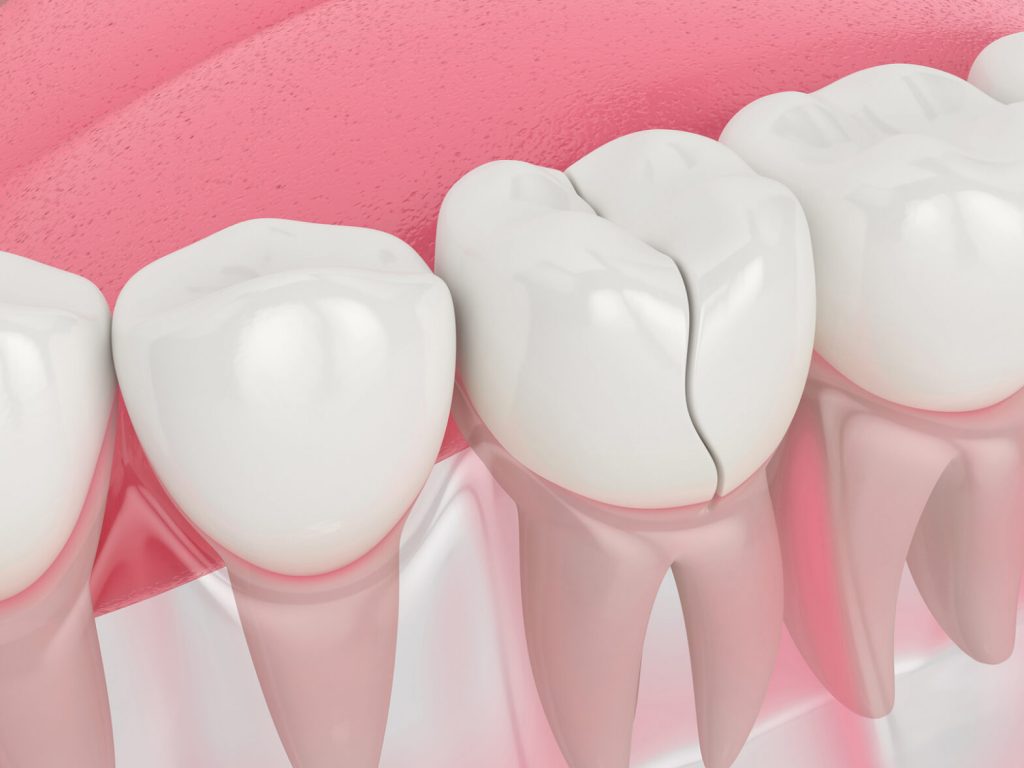You won’t be able to see it, but you’ll know it’s there. Minuscule cracks can form on your teeth, threatening your dental health. Although small in stature, these cracks can do big damage. But don’t panic — with the right tools, you can stop cracked teeth in their tracks and possibly prevent them altogether.
Cracked tooth syndrome becomes more of a threat as we age. Our teeth tend to weaken as we get older, making them susceptible to tiny hairline fractures that aren’t visible to the naked eye. We increase our chances of developing cracked teeth by exposing them to trauma, such as bruxism and chewing on hard objects. Cracked tooth syndrome is also common in teeth that contain a large tooth filling, which can weaken any remaining healthy tooth structure over time.
Cancel Your Dinner Plans
Cracked teeth can really ruin a meal! Cracks are portals into the inner workings of your teeth, which is why it hurts while you’re chewing. Pressing an object against the tooth opens the crack, causing the underlying dentin to move and irritating the pulp chamber (which contains the tooth’s nerves). When the pressure is released, the crack immediately closes, causing a sharp pain. If left untreated, the pulp will eventually become damaged and you’ll start to feel sensitivity to hot and cold or prolonged pain.
The Type Your Mother Warned You About
There are several types of cracked teeth to be aware of, each requiring a different dental treatment plan:
Fractured Cusp — This happens when the cusp (the raised section of the biting surface of your tooth) becomes fractured. If a fractured cusp doesn’t break off on its own, it will need to be removed by a dentist and replaced by a dental crown.
Cracked Tooth — These cracks usually run vertically, originating from the top part of the crown and working their way down. Treatment typically entails a root canal followed by a dental crown. If the crack has extended below the gum line, the tooth may require a tooth extraction.
Split Tooth — When a cracked tooth is not treated, the crack can extend beyond the root, causing the tooth to split. Although these teeth are difficult to save, they can sometimes be treated with a root canal.
Vertical Root Fracture — Sometimes the crack starts at the bottom of the root and works its way up. If caught early, endodontic dental surgery may correct the situation.
Cracked teeth are different from crazing, where visible surface cracks appear on the tooth enamel. Crazing becomes more common as we age. Although crazing doesn’t look pretty, it is harmless.
You’ll Have to Find Me First
Whereas crazing is easy to spot, cracked teeth aren’t so obvious. Cracks don’t show up on X-rays, leaving your dentist to rely on old-fashioned investigation techniques to find the culprit. Since you won’t be able to tell which tooth is causing the pain, your dentist will perform a bite test to find the fractured tooth. You’ll bite down on an instrument that’s placed on one section of a tooth — if you don’t feel anything, your dentist will move the instrument to a different tooth until the source of your pain is found.
Wanted: Cracked Teeth
As you’ve seen, the treatment for cracked teeth depends on the type of crack and the amount of damage that’s done. The earlier you catch a cracked tooth, the easier it is to save. In fact, cracks that have recently developed on the surface of the tooth may only require a dental crown. But if your fractured tooth needs a root canal, don’t feel discouraged. Not only can a root canal save your tooth from extraction, but it may preserve your tooth for the rest of your life!
You do have the ability to prevent cracked teeth. Practicing excellent oral hygiene, maintaining a healthy diet and visiting your dentist regularly will strengthen your teeth against fractures. Should you experience any symptoms of cracked tooth syndrome, see your dentist as soon as you can.

